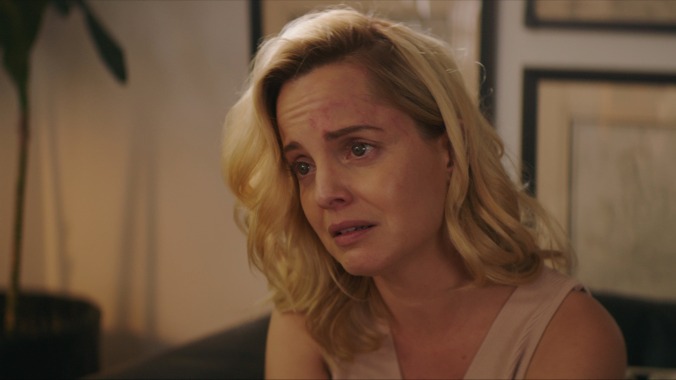The director of The Haunting Of Sharon Tate sets his ghoulish sights on The Murder Of Nicole Brown Simpson


For his latest shameless dive into the deep end of true-crime conspiracy theory, director Daniel Farrands appears to have taken inspiration from O.J. Simpson, or at least from his defense lawyers. Namely, Farrands’ guiding principle in making The Murder Of Nicole Brown Simpson seems to have been: If he doesn’t commit, the audience must acquit. But Farrands’ smug refusal to stick to any of his outrageous implications—he’s “just asking questions,” in a manner not unlike a troll “playing devil’s advocate” online—actually makes the film and its many red herrings all the more contemptible. Farrands conflates Nicole Brown Simpson and Ron Goldman’s gruesome deaths by stabbing on June 12, 1994 with the possible presence of a serial killer nicknamed the “Casanova Killer” in the Brentwood area. But he doesn’t exactly exonerate O.J. Simpson (Gene Freeman, who looks nothing like the real person) either.
To that end, the killer’s face and hands are conveniently covered when it’s time to recreate the real-life pain and suffering that are this film’s raison d’être. Farrands also rolls one of Brown’s real 911 domestic violence calls over the film’s end credits, a final touch that seems inserted deliberately to confuse and unsettle. Note here that the movie also implies, but doesn’t say outright, that the ghost of Charles Manson was involved in the murders. (This invisible malignant force is called just “Charlie,” but given that Farrands’ last movie was The Haunting Of Sharon Tate, it’s obvious who they mean.) That’s right: Farrands appears to be engineering a cinematic universe connecting the murders of famous women, with Manson as the thread that unites them all.
The director builds this brazen, tasteless attempt at franchise-building on some real but unreliable testimony. Firstly: an Investigation Discovery documentary called My Brother The Serial Killer that aired in 2012, in which a man named Clay Rogers claims he’s “absolutely certain” that his brother, convicted serial killer Glen Rogers, killed Nicole Simpson and Ron Goldman, citing “proof” he wasn’t able to produce for the documentary crew. Secondly: a 2006 interview in which O.J. Simpson claimed that a “friend” named “Charlie” accompanied him to Brown’s home on the night of the murders. In the interview, Simpson said that he took the knife from “Charlie” after “Charlie” started stabbing Brown, but “after that I don’t remember.” If Glen was Charlie—possessed by the spirit of LA’s most famous cult leader, perhaps?—then the whole thing comes together rather neatly. Whether any of it is true doesn’t matter one bit to Farrands or to his screenwriter, Michael Arter.
It also doesn’t seem to matter to Mena Suvari, whose career admittedly plateaued after a promising start in the late ’90s but who still gets enough work that she must have really believed in this project in order to sign on. (She’s also listed as an executive producer.) Suvari is more competent in her role as Nicole Brown Simpson than Hillary Duff was as Sharon Tate, putting more care and empathy into her portrayal than the film’s subtle-as-a-sledgehammer dialogue really deserves. And the paces Farrands puts his lead actress through as Brown’s paranoia grows are ghoulish, culminating in a dream sequence that blatantly rips off an iconic death scene from A Nightmare On Elm Street. Then there’s the scene where Brown contemplates a white Bronco parked outside of her birthday party, one of a handful of crass “Easter eggs.”
Suvari delivers the only remotely credible performance here. She’s certainly better than Taryn Manning, who plays Brown’s friend Faye Resnick as a combination Rachel Dratch and Amy Sedaris character, lending an unintentional SNL vibe that’s enhanced by Agnes Bruckner’s pursed-lip posturing as Kris Kardashian. Meanwhile, Nick Stahl seems to have taken a wrong turn at a 30 Seconds To Mars cover band audition, but ended up getting cast as drifter serial killer Glen Rogers anyway. There are many exploitative moments in The Murder Of Nicole Brown Simpson, but Stahl has perhaps the most risible of them, arguing with “Charlie” in the middle of the night while pacing around Brown’s condo in the nude after the two have sex. (Brown is a terrible judge of character in this film, a subtle bit of victim-blaming that makes a cynical attempt at feminism where a cop asks Brown offensive questions about her wardrobe ring all the more hollow.) And poor Ron Goldman (Drew Roy), often forgotten in discussions of this tragedy, also gets the short shrift here.
The Murder Of Nicole Brown Simpson is directed like a Lifetime thriller, relying heavily on stark lighting and ominous music to create suspense. (Neither is effective.) It does possess a marginally more convincing sense of time and place than The Haunting Of Sharon Tate, Farrands better evoking the early ’90s with mom jeans and fax machines than he did the late ’60s with haphazardly draped paisley. But you can’t give him too much credit there, considering that many Southern California shopping centers—locations that feature prominently in the film—look about the same now as they did then. A more sensitive filmmaker might use this visual continuity to underline the fact that Nicole Brown Simpson and Ron Goldman’s deaths weren’t all that long ago, and that the sociopolitical wounds those murders tore open have not yet scarred over. But if the lingering hot-button sensitivity of that aspect had ever occurred to Farrands, he surely would have turned it into just another crass selling point.